Female Monastic Takes Robes in Port Townsend
Written by: Jill Boone
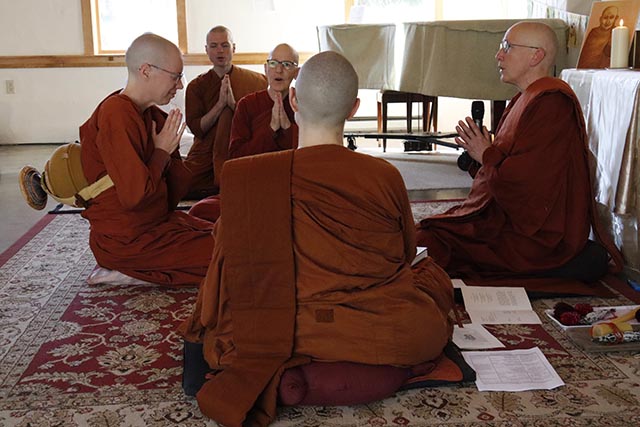
Monastics chant blessings for Sāmanerī Juṇhāvarā.
Photos by: Courtesy of Aloka Vihara
It was an auspicious day, the full moon of October 29, 2023, when Anagārikā Bethany Axtman left her worldly life behind, and “went forth” as a sāmaṇerī (a novice, in the Theravāda tradition of Buddhism).
This ordination ceremony, known as pabbajjā or “going forth,” signifies leaving behind one’s home life, taking on monastic robes, giving up the use of money, and training in the 10 precepts of ethics and renunciation.
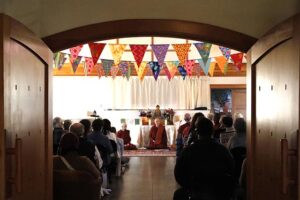
The ceremony took place at the Quimper Unitarian Universalist Fellowship in Port Townsend. Buddhist nun Ayya Ānandabodhī, who led the ceremony, had been living and practicing with Anagārikā Bethany in Port Townsend for several months. Port Townsend was chosen for Ayya Ānandabodhī’s sabbatical because it is a quiet, friendly town near the sea and woodlands, with some Buddhist practitioners as residents.
Ayya Ānandabodhī is a deeply practiced monastic, formerly co-abbot of the now-closed Aloka Vihara Forest Monastery in California.
Pabbajjā is an ancient ceremony that includes chanting, blessings, offerings and receiving a new name. The ceremony is conducted primarily in Pāli, the ancient language of early Buddhist teachings.
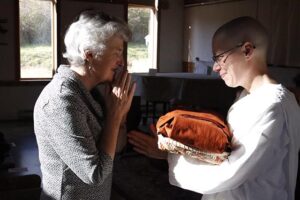
As part of the ordination ceremony, Anagārikā Bethany changed from her white anagarika robes into the brown robes of a sāmaṇerī and was given her new name, Juṇhāvarā, which can be translated as Excellent Moonlight. The Buddha often used similes of the full moon to point to the natural radiant state of the mind when it is free from unwholesome states. She will generally go by Sāmaṇerī Juṇhā.
One needs to have two essential supports in order to go forth into the monastic life: robe cloth, and an alms bowl. The robe cloth was offered by Kate Davies, a Buddhist meditation teacher from Whidbey Island. The alms bowl was offered by Crystie Kisler, a longtime friend of Bethany’s from Chimacum, a rural community south of Port Townsend. Anagārikā Bethany sewed her own monastic robes before the ordination, as part of her preparations.
Another essential element is to have the support of a bhikkhunī preceptor, a female Buddhist monastic, who has been fully ordained for at least 12 annual monastic rains retreats. Called vassas, these three-month retreats are traditionally held during the Asian monsoon, and go from the full moon of July to the full moon of October.
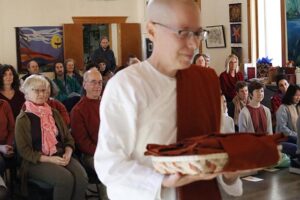
The preceptor should be willing to offer training, or to recommend another qualified bhikkhunī, to mentor the new novice. Ayya Ānandabodhī happily took on the responsibility of being Sāmaṇerī Juṇhā’s teacher and mentor during her time of training. Ayya Ānandabodhī completed 12 vassas on October 29, and was therefore able to be Sāmaṇerī Juṇhā’s preceptor.
As part of the traditional ceremony, Anagārikā Bethany asked for forgiveness from any faults, while offering a tray of flower, candles and incense. She also shared her merit with Ayya Ānandabodhī, who then reciprocated by sharing merit with her.
Part of Anagārikā Bethany’s requests during the ordination ceremony was, “Ayye, accepting this saffron robe, out of compassion, please give me the going forth, that I may escape suffering and realize nibbāna.”
Reflections were given on the five external signs of attractiveness: hair of the head, hair of the body, nails, teeth and skin. They were listed to be contemplated as they are, in their neutral, non-attractive form.

These steps were done in Pali, so the audience was only able to watch and listen to the chanting. Then, Bethany left to put on her new robes. After she returned, wearing her robes and carrying her alms bowl, she took the three refuges and 10 sāmaṇerī precepts with her preceptor, Ayya Ānandabodhī. At that moment, she became a sāmaṇerī.
Sāmaṇerī Juṇhāvarā then stated her dependence on her teacher, who will support her in spiritual guidance and training, and who will share the four monastic requisites. food, clothing, shelter and medicines. The relationship is one of mutual responsibility and care.
Finally Sāmaṇerī Juṇhāvarā chanted the “Ten Subjects for Frequent Recollection for One Who Has Gone Forth,” a traditional set of reflections that support deepening in the monastic training.

The ordination was attended by several monastics in addition to Ayya Ānandabodhī. These included Ajahn Nisabho, co-abbot of the budding Clear Mountain Monastery in the greater Seattle area; Ayya Ahimsā, from Canmore Theravada Buddhist Community (CTBM) in Alberta; Ayya Niyyānikā, who had spent the vassa on Bainbridge Island; and Anagārikā Sarah, also from CTBM. All came to witness and support the ordination. There were also about 55 people attending from as near as Port Townsend and as far as Sacramento, with friends, new and old, from many places in between.
The initial commitment for a sāmaṇerī is for one year, extended for a second year if that feels right for the novice and her teacher. A person must train as a sāmaṇerī for two years, to become eligible for full bhikkhunī ordination.
Once becoming a bhikkhunī, one continues to train with one’s teacher for an additional two years before being given “independence.” This gives time for external training in the monastic form, and internal training in one’s practice, which of course continues throughout one’s monastic life. The Buddha did not request a lifetime commitment to the robes, though some choose to give their lives to monastic practice and training.

This radical step of going forth from home to homelessness supports simplification of one’s life and minimizes distractions. This gives more time for meditation, and for investigation of the patterns of one’s heart and mind that cause obstructions on the path.
Monastics are encouraged to cultivate contentment through reflecting on the four requisites of food, clothing, lodging, and medicine as a support for their physical needs, and on the generosity of those who offer these requisites. Monastics endeavor to generate a heart of mettā (loving kindness) for all beings, to cultivate mudita (sympathetic joy) to counter dissatisfaction and discontent, to generate a heart of karuna (compassion) for all beings, and to develop upekkha (equanimity) in relation to the pushes and pulls of the sense world.
Sāmaṇerī Juṇhā has led an adventurous and interesting life. She was raised in North Dakota and lived her adult life in the Pacific Northwest.
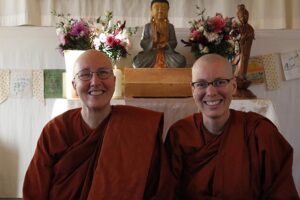
A hike of the Pacific Crest Trail in her late 20s, led to many other long-distant hikes in an effort to fully understand the relationship between her mind and her experiences. Meeting the dharma created a shift toward meditation as a process of awakening. As her practice steadily grew and deepened, the question of “How do I live this?” was persistent.
When she discovered the Western Bhikkhunī monastic form, she met women who were living the whole-life practice that she had been imagining. She knew she wanted to be part of a tradition that is formed from generations of collective wisdom.
Sāmaṇerī Juṇhā describes her practice and motivation in this way: “I’ve seen again and again in my life how my ideas of what is possible are limited by the models that I can see in the world. I think it’s valuable and important to have a model of this ancient renunciate life, which turns many of the assumptions underlying our society’s values and customs on their head. It can expand people’s perception of what is possible, even if this particular form isn’t ever going to be a popular choice.”
Ayya Ānandabodhī and Sāmaṇerī Juṇhā will remain in the Port Townsend area for the coming year. If you would like to support their wellbeing and practice by offering meals, flowers or food, you can find out more at the Aloka Vihara website.
Jill Boone is a long-time supporter of Buddhist nuns. With these nuns and others she founded the Saranaloka Foundation, which supports Aloka Vihara and the Aloka Earth Room.
